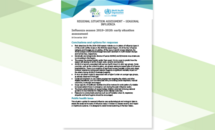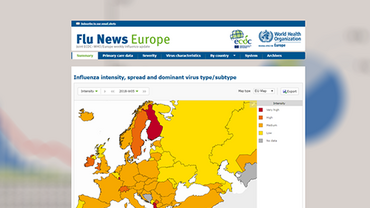Regional situation assessment - Seasonal influenza, 2019–2020
This situation update for seasonal influenza uses epidemiological and virological data to assess the seasonal increase of influenza cases in relation to disease severity and impact on healthcare systems. It is designed to assist forward planning in Member States.
Executive Summary
- First detections for the 2019–2020 season indicate co-circulation of influenza types A (71%) and B (29%) viruses in the WHO European Region. All of the four influenza subtypes and lineages are circulating. Of the types A and B viruses detected, the A(H3) subtype and B/Victoria lineage have been dominant in north-western Europe and Central Asia, respectively.
- Genetically and antigenically diverse influenza A(H3N2) and B/Victoria virus strains are co-circulating in the Region.
- The season has started slightly earlier than usual. It is too soon to predict how the season will develop in terms of peak week, severity and duration.
- A(H3N2) is typically associated with serious health impact in older age groups. Some countries, such as the United Kingdom, are already seeing increased rates of influenza hospitalisation. There is no evidence of significant excess mortality at this early stage, however experience during past seasons suggests a significant mortality impact on the elderly during A(H3N2) dominated seasons.
- B virus circulation might be associated with a higher burden on younger age groups, as already observed in Portugal.
- Continued emphasis on vaccination programmes targeting the elderly and other eligible populations, such as individuals with pre-existing cardio-respiratory medical conditions, is strongly encouraged.
- Surge capacity of healthcare facilities should be reviewed in anticipation of probable increased patient flows in emergency care during the peak influenza weeks.
- The timely administration of neuraminidase inhibitor antivirals following national guidance is recommended to mitigate severe disease outcomes.
- Measures to communicate practices such as self-isolation when ill, respiratory etiquette and hand hygiene should be encouraged.
Download

News story
2019 Seasonal influenza assessment: currently dominating viruses point at possible heavy impact on the elderly and healthcare systems
The first virus detections for the 2019/2020 season indicate co-circulation of influenza types A (71%) and B (29%) viruses in the WHO European Region. This is a mix which potentially could result in high mortality in elderly patients and a heavy burden on healthcare services, warns the European Centre for Disease Control and Prevention (ECDC) and World Health Organization (WHO) Regional Office for Europe in a joint assessment issued today.






